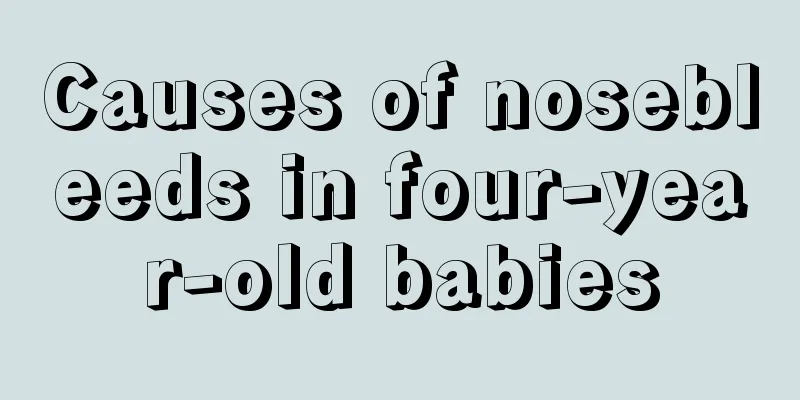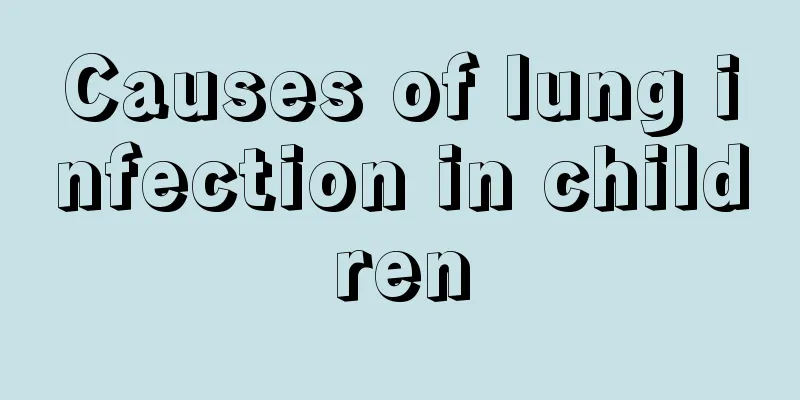Causes of nosebleeds in four-year-old babies

|
Nosebleed is something that many friends will encounter. Regarding this physical condition, nosebleed often makes everyone very panic, especially when this symptom occurs in children, it often makes adults very worried. So what is the reason for baby's nosebleed? What are the harms to the body? Let’s take a look at what the relevant experts have to say about this symptom. I hope it can help everyone better understand this symptom. 1. Generally, children's nosebleeds are caused by damage to the mucous membrane in the Li area of the nasal vestibule. Because this small area is rich in blood vessels, nosebleeds will occur once damaged. Common causes of injury to this area include: picking the nose, collision (trauma), rubbing the nose in dry weather, etc. If a child has a nosebleed after catching a cold, it is probably because he wipes his nose too much, causing damage to the mucous membrane in the nasal vestibule area. 2. It may be because the air is relatively dry, and the nasal mucosa is also relatively dry, fragile, and prone to bleeding. You can go to the hospital to get some paraffin oil or peppermint oil to apply to the nasal cavity, or you can find a soft plastic straw, wash it, suck in vegetable oil (you can use it for cooking) and then drip it into the nose. This mainly plays a lubricating role. This also has no side effects. Suggestions: If a child has a nosebleed when crying, consider that it is related to the sudden increase in blood pressure when the child cries, which breaks the capillaries in the area. If the amount of bleeding is small and stops immediately, there is no need to worry. If the bleeding is heavy, you can first plug the bleeding nostril with clean cotton or paper towels and apply appropriate pressure, which will help stop the bleeding. If the bleeding still cannot be stopped, you should go to the hospital and ask an ENT doctor to treat it. You can usually apply tetracycline eye ointment or chloramphenicol eye ointment to moisten the nasal mucosa. You can also make soup with Adenophora sibiricum, Polygonatum odoratum, etc. to replenish yin and moisturize. Regarding the relevant knowledge about nosebleeds in four-year-old babies, the editor will introduce these to you, hoping to help you better understand this physical symptom. When the child shows related symptoms of the disease, be sure to go to a regular medical institution in time and take reasonable treatment measures as soon as possible to avoid worsening of the disease and aggravating the harm to the child. For more relevant knowledge, you can read other articles on our website. |
<<: Why is the three-year-old baby walking unsteadily?
>>: What to do if your baby always has nosebleeds
Recommend
What to do if your child has an itch?
Many children sometimes experience itching on the...
What can children eat to gain weight? These nutrients should keep up
Many mothers are envious when they see other babi...
What to do if your child has dry lips
We all know that children's dry lips may be c...
Six-year-old child's tongue coating is thick and white
If a 6-year-old child has a thick white tongue co...
Is it good for children to drink milk in the morning?
Milk is nutritious and rich in calcium. Many pare...
Treatment of low-grade fever in infants
In our lives, it may often happen that children h...
How to prevent baby from bloating when drinking milk?
Young babies do not know how to pause when drinki...
What should I do if my child has ADHD?
Many parents worry that their children will not b...
Can children eat beer duck?
Many delicious dishes can be made with beer. Dish...
What should children with appendicitis eat?
Generally, children are not allowed to eat anythi...
What to do if your three-year-old baby's teeth are black
Nowadays, many babies' teeth have turned yell...
From whom does the daughter inherit more genes?
Children all have certain genes, and these genes ...
Parents should avoid patting the back of the baby's head when caring for the baby
The back of the baby's head is relatively fra...
What should I do if my 2-year-old child has diarrhea?
When a child has diarrhea, it is a symptom of a d...
What to do if your baby won't eat
The physical health of babies is an issue that pa...









